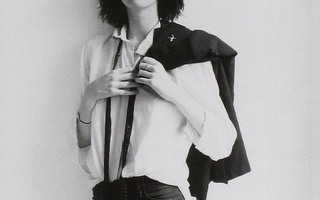{shortcode-d1d1dd987d2ca5f5c4d6b72e3e67bc70f6feec2e}After capturing the hearts of indie-pop enthusiasts back in 2013 with their eponymous debut album, The 1975 have released their highly anticipated follow-up. An initial glance at the album art alone in “I Like It When You Sleep, for You Are So Beautiful Yet So Unaware of It” hints at a slight stylistic shift in the band’s image. The white, clean, contemporary cover, in contrast to the black, vintage cover of their first album, suggests the 1975 are electing to maintain their signature minimalist visual aesthetic, but with an obvious attempt at some sort of artistic expansion. The change is intriguing and leads fans to think there might be a significant sonic twist to go along with it. However, though “I Like It When You Sleep…” features brief, exhilarating flashes of experimentation that showcase a new and interesting dimension of the band, the album lacks an overall sense of direction and ultimately suffers due to its underwhelming predictability.
Certain portions of the album show The 1975 at the best they’ve ever been: The same combination of groovy synth-pop and intrepid, intelligent lyrics that we saw in their debut album here evolves to become more sharp, lucid, and intense. “Love Me”—the album’s first and best track—is a blast of energy that finds The 1975 basking in creative euphoria, marrying sonic themes from the ’80s with a cheeky modern twist. The track is driven by arrestingly brilliant lyrics that are equal amounts playful and astute. Notably, lead vocalist Matty Healy at one point plays with elements of rhythm and consonance to deliver the line “caught up in fashion / Karcrashian panache / a bag of bash for passion,” marking a new level of inventiveness for the band. Moreover, “Somebody Else,” a gem likely easily overlooked due to its soft, unassuming character, highlights the band’s budding versatility and acts as a break from cheerful pop to delve into something more muted and understated. Here we find frontman Healy in complete command, artfully subduing his voice to tap into a melt-worthy kind of tenderness, to encapsulate the heartbreak that comes with seeing a lover “intertwining [their] soul with somebody else.” But in the end, it’s frustrating and unfortunate that no matter how strong these individual tracks are or how indicative they are of musical flair and maturation, they ultimately disintegrate under the album’s lack of focus and cohesion.
Apart from a few exceptional songs, the rest of the album’s offerings are largely either boring or bewildering. Even disregarding its unusually extensive length of 17 tracks that span nearly 75 minutes, the album is often grueling to get through because of how uninspiring and unsuprising the rest of its content is. The majority of the album has the same musical style as tracks like “The Ballad of Me and My Brain” and “She’s American”—songs that aren’t necessarily unpleasant to listen to but lack conviction and sound too much like more lackluster versions of songs from the band’s previous album. Here, The 1975 does itself a disservice by resting on safety rather than engaging in more creative risk-taking; the result finds the band at a standstill, unwilling to take bigger steps forward despite already having demonstrated the creativity and artistic prowess to do so and succeed. Even their occasional stabs at creativity only serve to accentuate the distracting, disorderly nature of the album—an outstanding piece if only for its utter incongruity, “If I Believe You,” creates such a glaring disconnect that it’s hard to believe that the track is even part of the album at all. Though its lyrics are amply substantive, the track as a whole is essentially sluggish, strange, and soporific. Other tracks, such as “This Must Be My Dream” and “Paris,” are too reliant on elements from prior works to possess their own unique identities. An unfortunately significant portion of the album similarly finds The 1975 creatively flat and as a result, translates as wastefully mediocre.
The electrifying and poignant moments of “I Like It When You Sleep…” powerfully attest to The 1975’s capacity to reach new creative heights and to continue making stylish, dynamic art; still, an underlying inclination towards dependence on previous sound renders their sophomore album fundamentally flawed and expressive of shaky maturation at best. With the originality and talent the band has already proven to have, it’s painful to know they could have created something more compelling and exciting—but ultimately didn’t.
Read more in Arts
Hear Me Out: Mitski, 'Your Best American Girl'Recommended Articles
-
Real Estate Return With Sun-Soaked AlbumThough the band stays true to the relaxed ambiance of their earlier work, they have undoubtedly developed a more refined sound than that of their eponymous debut LP, and they successfully add a more mature element of nostalgia for baked skin and windswept sand. The result is a lovely and cohesive album that straddles the reality of today and the dream-state of summer’s yesterday.
-
 “To Pimp A Butterfly” A Provocative and Ground-Breaking Collage
“To Pimp A Butterfly” A Provocative and Ground-Breaking Collage -
Birdy Lets Her Hair Down In ‘Beautiful Lies’In "Beautiful Lies," Birdy shows a side that is gorgeously complex and daringly individual.
-
Ten Years After ‘Riot,’ Paramore Pops Back at Boston Opera HouseThe younger audience proved that the classic Noughties rock band’s foray into poppier climes with their newest album “After Laughter” is garnering them new, enthusiastic followers.
-
 This Year in Rock Music: 1975
This Year in Rock Music: 1975













